Introduction
The OSC Measure assesses organization-level culture, climate, and work attitudes. National norms for the scales are available from separate nationwide samples of agencies providing mental health services and child welfare services. Standardized scores and corresponding organizational profiles can be computed using norms from either of these nationwide samples.
The social context of an organizational unit includes the culture, climate, and work attitudes of the unit. Culture guides how things are done in the unit and describes the unit’s expectations of its members (eg, individual service providers). Climate describes the psychological impact of the work environment on the individuals who work there. Work attitudes reflect the morale of the members, which is measured as their job satisfaction and organizational commitment. Organizational social context has been found to enhance or inhibit the adoption of best practices; strengthen or weaken fidelity to established protocols; support or attenuate the relationships between unit members and consumers; and increase or decrease the availability, responsiveness, and continuity of the services provided by the organization.
The OSC Measure provides a snapshot of organizational social context that can be used to describe a particular organizational unit at one point in time. Multiple administrations of the OSC Measure (eg, once a year) can be used to monitor changes in social context over time.
The OSC Measure assesses organizational culture, organizational climate, and work attitudes. Organizational culture includes three primary scales: proficiency, rigidity, and resistance. Organizational climate also includes three primary scales: engagement, functionality, and stress. Additionally, worker attitudes are assessed as job satisfaction and organizational commitment, which compose morale.
The Primary Dimensions of Organizational Culture
The OSC Measure assesses organizational culture using three second-order scales:
Proficiency
Proficient cultures are characterized by expectations that the organizational unit’s direct service providers will place the well-being of each client first, and will be competent and have up-to-date knowledge. Proficiency consists of both competency and responsiveness. Competency describes the emphasis that is placed on training, up-to-date knowledge, and expectations of excellence in skills and abilities. Responsiveness describes the extent to which service providers are expected to meet each client’s needs.
Rigidity
Rigid cultures are characterized by service providers who have limited discretion and flexibility in their work, have limited input into key management decisions, and are controlled by extensive bureaucratic rules and regulations. Rigidity includes both centralization and formalization. Centralization indicates the degree to which power and decision-making are in the hands of relatively few members of the unit while formalization characterizes the level of procedural specifications that guide work-related interactions among members of an organizational unit.
Resistance
Resistant cultures are characterized by expectations that direct service providers will show little interest in change or in new ways of providing service, and suppress any opportunity for change. Resistance includes apathy (passive) and suppression (active) behavior. Apathy assesses the level of resignation and inactivity towards change, while suppression captures expectations of criticism and opposition that undermine openness and innovation.
The Primary Dimensions of Organizational Climate
The OSC Measure assesses organizational climate using three second-order scales:
Engagement
Engaged climates are characterized by front-line employee perceptions that they are able to accomplish many worthwhile things in their work, personally involved in their work, and concerned about their clients. Engagement includes both personalization and personal accomplishment. Personalization indicates the degree to which organizational members feel involved with their clients. Personal accomplishment assesses perceptions of members’ own success with clients.
Functionality
Functional climates are characterized by front-line employee perceptions that they receive the cooperation and help from coworkers and administrators required to do their jobs, have a clear understanding of how their responsibilities fit within the work of the organization, and have the opportunity for personal growth and professional development. Functionality includes perceptions that continual professional development and advancement will occur, that expectations for one’s work are clearly presented, and that organizational unit members will assist and support one’s work when needed.
Stress
Stressful climates are characterized by front-line employee perceptions that they are emotionally exhausted from their work, pulled in different directions, and unable to get necessary things done. Stress is identified by emotional exhaustion, role conflict, and role overload items. Respectively, these include perceptions of feeling overwhelmed, experiencing multiple conflicting demands, and having impossible amounts of work to accomplish.
Morale
Work attitudes are characterized primarily by morale, which is composed of employees’ satisfaction with their jobs and their commitment to the organization. Job satisfaction represents a positive appraisal of one’s job tasks and experiences. Organizational commitment represents a willingness to exert considerable effort on behalf of the organization and a strong desire to remain a member of the organization.
OSC Profiles
After members of an organization complete the OSC Measure, we create an organizational profile that can be compared to the organizational profiles of national samples of child welfare or mental health organizations. OSC profiles are developed for culture and climate using the three primary dimensions for each construct, as well as a profile of work attitudes using the construct of morale. OSC profiles vary considerably across organizations that do similar work, and while the dimensions are correlated, many different types of profiles can be expected. For example, roughly 10% of mental health organizations nationwide exhibit the “best” profile and about 10% exhibit the”worst” profile for both culture and climate.
Examples of OSC Profiles
Below are the actual best and worst culture profiles found in the national sample of 100 mental health agencies.
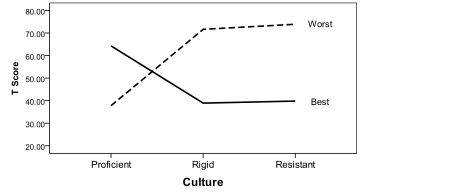
Below are the best and worst climate profiles found in the national sample of 100 mental health agencies.
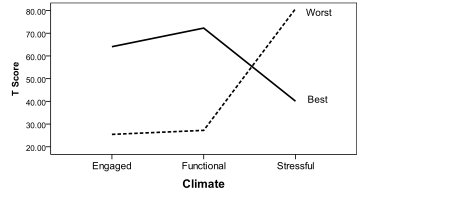
The graph below shows the variability of actual OSC culture profiles in the national sample.
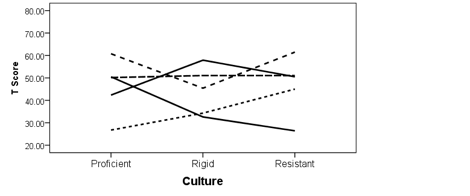
The graph below shows the variability of actual OSC climate profiles in the national sample.
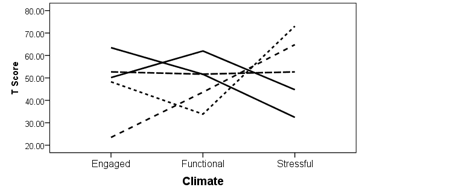
The graph below shows the variability of actual OSC work attitudes profiles in the national sample.
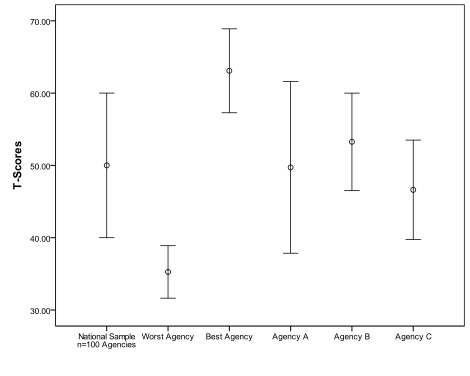
Click here to go back to OSC Measure page.